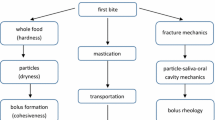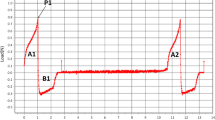Abstract
Research of food oral processing is turning into progressively more needed with the increase of elderly people around the world. A new strategy for instrumental assessment of texture perception is needed, being also desirable to measure dynamic bolus formation and rheological properties for a better understanding. Banana, apple, carrot, cured ham, peanut and potato chips are solid foods with very different texture. Kramer test, performed with a miniature cell, could be very appropriate to establish an instrumental standardized approach of solid foods texture evaluation, and even of bolus counterparts, enables to know how foods mechanical properties change during dynamic oral processing.
Access provided by Autonomous University of Puebla. Download conference paper PDF
Similar content being viewed by others
1 Introduction
Food oral processing is an essential and complex process narrowly related to foods sensory perception, especially to texture perception [1]. In turn, texture perception is a dynamic mechanism which depends on food properties such as composition, structure, and changes which take place during oral processing [2]. Miniature Kramer cell close up mimic the early stage of mastication. To our knowledge, there is no literature relative to its use for objective measures of food texture, and still few researches relate bolus mechanical properties to dynamic texture perception.
The aim of this work was to carry out a comprehensive study of the texture of six solid foods (banana, apple, carrot, cured ham, peanut and potato chips). Firstly, the mechanical properties of solid foods were measured using a miniature Kramer cell. In carrot, peanut and potato chips, acoustic properties were also recorded. Secondly, the dynamic rheological properties of boluses were measured. Thirdly, a sensory evaluation was performed by an untrained panel, and involved measures of oral physiological parameters (chewing duration, chews number, chew rate and average eating rate). Pearson correlations were established to find relationships between foods and boluses mechanical properties and texture perception.
2 Materials and Methods
2.1 Solid Food Items
Canarian banana, Golden Delicious apple, Nantesa packaged carrot (Horticola ES-MA, S.L., Valladolid, Spain), dices of Serrano cured ham (Incarlopsa, Cuenca, Spain), fried peanut (Importaco Casa Pons Sa, Valencia, Spain) and potato chips (CylIbersnacks S.L., Valladolid, Spain) were acquired from a local supermarket (Mercadona, Madrid, Spain).
2.2 Mechanical Properties of Solid Foods and Boluses
Mechanical properties of solid foods were measured using a TA.HDPlus Texture Analyser Stable Micro Systems Ltd., Godalming, UK) equipped with a 250 kg load cell. Objective measurements were carried out by using a miniature Kramer shear (HDP/MK05) cell at deformation rate of 2 mm/s. A constant food volume fixed at ≈5.20 cm3 was used. In carrot, peanut and potato chips, simultaneously with the force, the sound emitted during Kramer test was also recorded with an acoustic envelope detector (AED) [3].
Rheological measurements of boluses were carried out using a rotational Kinexus pro rheometer (Malvern Instruments Ltd., Worcestershire, UK), which was equipped with a 40 mm parallel–plate geometry (1-mm gap) for measuring banana, apple and potato chips boluses and a 20 mm parallel–plate geometry (1.5-mm gap) for measuring carrot, cured ham and peanut boluses. Temperature was kept at 37 °C. To determine the linear viscoelastic (LVE) region, strain amplitude sweeps were run at 1 Hz by varying the shear strain (γ) from 0.01 up to 10%. Frequency sweeps were run subjecting boluses to stress that varied harmonically with time from 0.1 to 50 Hz and γ = 0.01%. All tests were carried out at least in quintuplicate.
2.3 Sensory Analysis
Sensory evaluation was performed by 39 participants completing several trials/tasks of the six foods corresponding to four stages of oral processing: non-oral evaluation, first bite, chewing process determining eating behaviors, and bolus characterization. During either non-evaluation or chewing process, participants selected from a list given the texture adjectives that they considered applicable for describing the expected and perceived texture of each food item. Chew rate and average eating rate were calculated in accordance with Wee et al. [4].
3 Results and Discussion
3.1 Mechanical/Acoustical Properties of Solid Foods
Great differences were observed in the shape of the Kramer force-distance curves depending on the food tested (data not shown). Carrot had significantly (P < 0.05) the highest Kramer forces, followed by peanut and cured ham, potato chips, apple and banana, in that order (Table 1). Carrot also required the highest work, and both carrot and potato chips had similar SPLmax and average drop off values.
3.2 Rheological Properties of Boluses
Rheology of spat-out boluses is shown in Table 2. Carrot bolus had the highest critical shear stress (σmax) and complex modulus (G*max) and the lowest shear strain amplitude (γmax), reflecting a denser with higher rigidity but less flexible physical network. On the contrary, cured ham bolus had the highest conformational flexibility (γmaxvalue) and the lowest structural complexity (tan δ value closer to 1). Boluses studied all exhibited weak gel properties, but the gel structure was weaker in banana and cured ham boluses.
3.3 Sensory Analysis
Potato chips were preferred to be eaten in first place. Main drivers of product choice were lifestyle, time of the day, appearance and expected oral sensations. However, the texture had little influence on foods choices before tasting. At first bite, carrot and banana were scored with the highest and the lowest perceived force and loudness degree, respectively. Saliva incorporation was estimated by subtraction between weight of bolus after mastication and that of food sample. In banana and apple, with higher water content, had no saliva incorporation (Table 3), whereas the contrary was true in carrot, cured ham, peanut and potato chips. Potato chips bolus had the highest saliva incorporation. Chewing time and chews number were longer and higher in carrot and cured ham. Banana and apple were the faster foods, while cured ham was the slowest one. Positive and significant correlations were found between the texture expectations before consumption, and textural attributes perceived by the participants during mastication. As an example, Fig. 1 shows the frequency of occurrence of the textural attributes selected before and after consumption for banana. By considering the six foods, correlations ranging between r = 0.823 (for expected and perceived hardness) and r = 0.993 (for expected and perceived gumminess) were found. On the other hand, carrot bolus was perceived as the least consistent and adhesive, whereas banana and cured ham boluses had the highest degrees of adhesiveness and consistency, respectively.
4 Conclusions
Kramer work would appear to be the best mechanical property for measuring the initial degree of structuring of the sixfoods studied. Critical stress (σmax), representing bolus crosslink density, was highly correlated with Kramer mechanical properties, reflecting that a higher degree of structure in food is associated with a higher bolus network density. Higher foods mechanical properties are linked to longer chewing duration, greater chews number and slower eating rate. Perceived hardness had positive correlations with both Kramer forces, σmax, G*max, G′, G″ and η*, and negative correlation with bolus adhesiveness, reflecting the interplay between texture perception, oral physiology and food properties.
References
Chen, J.: Food oral processing—a review. Food Hydrocoll. 23, 1–25 (2009)
Hutchings, J.B., Lillford, P.J.: The perception of food texture—the philosophy of the breakdown path. J. Texture Stud. 19, 103–115 (1988)
Salvador, A., Varela, P., Sanz, T., Fiszman, S.M.: Understanding potato chips crispy texture by simultaneous fracture and acoustic measurements, and sensory analysis. LWT - Food Sci. Technol. 42, 763–767 (2009)
Wee, M.S.M., Goh, A.T., Stieger, M., Forde, C.G.: Correlation of instrumental texture properties from textural profile analysis (TPA) with eating behaviours and macronutrient composition for a wide range of solid foods. Food Funct. 9, 5301–5312 (2018)
Author information
Authors and Affiliations
Corresponding author
Editor information
Editors and Affiliations
Rights and permissions
Copyright information
© 2020 Springer Nature Switzerland AG
About this paper
Cite this paper
Álvarez, M.D., Paniagua, J., Herranz, B. (2020). An Objective and Subjective Characterization of the Oral Processing of Six Solid Foods. In: Galindo-Rosales, F., Campo-Deaño, L., Afonso, A., Alves, M., Pinho, F. (eds) Proceedings of the Iberian Meeting on Rheology (IBEREO 2019). IBEREO 2019. Springer Proceedings in Materials. Springer, Cham. https://doi.org/10.1007/978-3-030-27701-7_15
Download citation
DOI: https://doi.org/10.1007/978-3-030-27701-7_15
Published:
Publisher Name: Springer, Cham
Print ISBN: 978-3-030-27700-0
Online ISBN: 978-3-030-27701-7
eBook Packages: EngineeringEngineering (R0)





